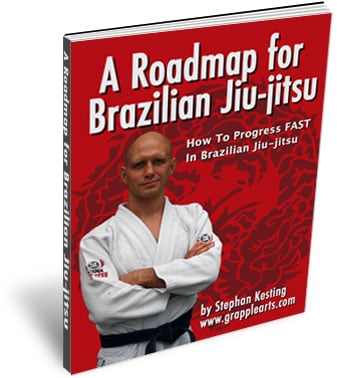
It’s easy to get sidetracked in Brazilian Jiu-Jitsu. Whether it’s the Worm Guard, the Berimbolo attack or some crazy submission, there’s always the temptation to train the latest, greatest technique to the exclusion of all other moves.
I’m actually OK with some degree of shiny object syndrome.
Most people doing BJJ are doing it for fun. And if you’re having fun trying to incorporate a one-handed-cartwheel-sleeve-choke-entry into your game then who am I to judge!
But it’s a question of degrees…
Spend 20% of your training time on the one-handed-cartwheel-sleeve-choke entry, AND spend 80% of your training time on the tried-and-true techniques, making sure to round out your skill set.
But which specific skills should you work on?
Well, that’s what this email is all about!
Early in your BJJ development you should be a generalist.
This means developing basic skills in ALL areas of BJJ. (Eventually you’ll probably specialize a little bit more, but that comes much later, usually around purple belt).
So for now you need to make sure that you’re covering all your bases. You really don’t want there to be severely underdeveloped areas of your game!
One way to figure out whether there are major holes in your game is to use a checklist like the one below.
Here are the 6 major positions (with 3 sub-positions) in BJJ. Try ranking them in order of how much you know about them:
1a) Closed guard
1b) Open guard
1c) Half guard
2) Side mount
3) Knee mount
4) Full mount
5) Rear mount
6) Turtle position
(If you want a more detailed breakdown of these positions please download my free book A Roadmap for Brazilian Jiu-Jitsu)
This ordered list of 8 positions then becomes a handy tool to decide which techniques to practice, and what positions you should start your sparring in.
Remember, usually you make your fastest progress by working your weakest area!
But if you want to get even more organised in your training then subdivide these positions even further.
Lets split each of the above positions into three technical areas:
- Submissions from that position.
- Transitions from the position to an even better position.
- Escapes/guard passes if you’re caught in that position.
When we take consider those three types of skills for each of the major positions, we end up with 24 skill sets:
- Closed guard submissions
- Closed guard passes
- Closed guard sweeps
- Open guard submissions
- Open guard passes
- Open guard sweeps
- Half guard submissions
- Half guard passes
- Half guard sweeps
- Side mount submissions
- Side mount transitions
- Side mount escapes
- Knee mount submissions
- Knee mount transitions
- Knee mount escapes
- Full mount submissions
- Full mount transitions
- Full mount escapes
- Rear mount submissions
- Rear mount transitions
- Rear mount escapes
- Turtle submissions
- Turtle transitions
- Turtle escapes
Normally I don’t assign homework, but I want you to try this. Go down this list of 24 skills and figure out if you know at least two techniques for each area.
To be able to flow and spar and play and feel comfortable on the ground you need to have at least a few good options for each one of the above 24 areas.
This approach also helps you identify areas for improvement.
Hypothetically, let’s say that you know 17 different sweeps from the open guard, but you’re completely lost when you get stuck in the half guard.
Question for you: if that’s the case, should you work on more open guard techniques, or spend some quality time on the half guard?
 I bet you just answered the question yourself, didn’t you?
I bet you just answered the question yourself, didn’t you?
P.S. On pages 29 to 31 of my Roadmap for Brazilian Jiu-Jitsu book there are lots of examples of specific techniques for each of the 24 skills mentioned above.
Click here to download the Roadmap for BJJ book for free from Grapplearts.com


